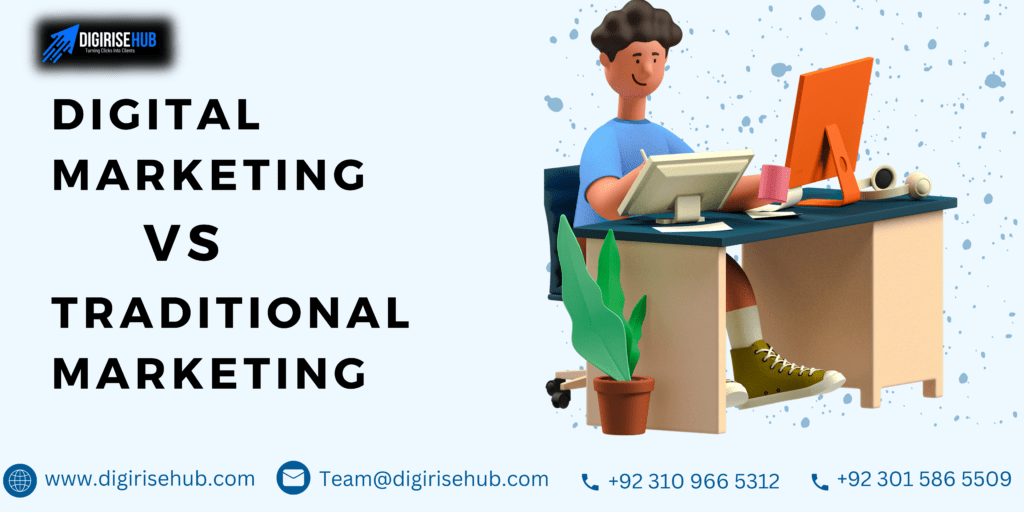In today’s fast-paced world, marketing has evolved significantly. Businesses now have two primary ways to reach their audience: digital marketing and traditional marketing. But what exactly sets them apart? If you’re trying to decide which approach is best for your business, this blog will break down the key differences between the two in a simple, easy-to-understand way.
What is Traditional Marketing?
Traditional marketing refers to the conventional methods of promoting products or services that have been used for decades. These methods include:
- Print Ads (newspapers, magazines, brochures)
- Broadcast Ads (TV and radio commercials)
- Direct Mail (postcards, catalogs, flyers)
- Outdoor Ads (billboards, posters, banners)
- Telemarketing (phone calls to promote products)
Traditional marketing has been the backbone of advertising for years. It’s tangible, familiar, and often reaches a broad audience. However, it’s not as targeted or measurable as digital marketing.
What is Digital Marketing?
Digital marketing, on the other hand, leverages online platforms and technologies to promote products or services. It includes:
- Search Engine Optimization (SEO) (improving website visibility on search engines)
- Social Media Marketing (ads and content on platforms like Facebook, Instagram, and LinkedIn)
- Email Marketing (sending promotional emails to subscribers)
- Pay-Per-Click (PPC) (paid ads on Google or social media)
- Content Marketing (blogs, videos, infographics)
- Influencer Marketing (collaborating with influencers to promote products)
Digital marketing is highly targeted, cost-effective, and allows businesses to track results in real-time. It’s ideal for reaching tech-savvy audiences and adapting quickly to market trends.
Key Differences Between Digital Marketing and Traditional Marketing
Let’s dive deeper into the main differences between these two marketing approaches:
1. Target Audience
- Traditional Marketing: Reaches a broad audience, but it’s harder to target specific demographics. For example, a billboard is seen by everyone passing by, regardless of their interest in your product.
- Digital Marketing: Allows precise targeting based on age, location, interests, and online behavior. You can show ads only to people who are likely to be interested in your product.
2. Cost
- Traditional Marketing: Often more expensive due to printing, distribution, and ad placement costs. A TV commercial or a full-page magazine ad can cost thousands of dollars.
- Digital Marketing: Generally more affordable, especially for small businesses. You can run a social media ad campaign with a small budget and still see results.
3. Measurability
- Traditional Marketing: Difficult to measure effectiveness. For example, how do you know if someone bought your product because they saw your billboard?
- Digital Marketing: Highly measurable. Tools like Google Analytics and social media insights let you track clicks, conversions, and ROI in real-time.
4. Engagement
- Traditional Marketing: One-way communication. The audience can’t interact with a TV ad or a newspaper.
- Digital Marketing: Two-way communication. Customers can like, comment, share, or message you directly, creating a more engaging experience.
5. Flexibility
- Traditional Marketing: Changes are costly and time-consuming. Once a print ad is published, you can’t edit it.
- Digital Marketing: Highly flexible. You can tweak your ad campaigns, update content, or change strategies on the go.
6. Reach
- Traditional Marketing: Limited by geography. A local newspaper ad won’t reach someone in another country.
- Digital Marketing: Global reach. Your website or social media page can attract customers from around the world.
Which One Should You Choose?
The choice between digital and traditional marketing depends on your business goals, target audience, and budget. Here’s a quick guide:
- Choose Traditional Marketing If:
- Your target audience is older or less tech-savvy.
- You want to build brand awareness in a specific local area.
- You have a larger budget and want to create a tangible presence (e.g., billboards, brochures).
- Choose Digital Marketing If:
- Your audience is online and active on social media.
- You want to target specific demographics and track results.
- You have a limited budget but want to maximize ROI.
Can You Use Both?
Absolutely! Many businesses use a combination of both digital and traditional marketing to create a well-rounded strategy. For example, you could run a TV ad to build brand awareness and use social media ads to drive traffic to your website. This approach is often called integrated marketing.
Final Thoughts
Both digital marketing and traditional marketing have their strengths and weaknesses. While traditional marketing offers a sense of familiarity and trust, digital marketing provides precision, flexibility, and measurable results. The key is to understand your audience, set clear goals, and choose the approach that aligns with your business needs.
In today’s digital age, having an online presence is crucial, but that doesn’t mean traditional methods are obsolete. By combining the best of both worlds, you can create a powerful marketing strategy that drives growth and success for your business.

